News
Exploring with the Dive Ninjas: Diving with Striped Marlin at Mexico’s Secret Sardine Run

It’s November and I’m waking up in a small fishing village on Bahia Magdalena. We are about to head 20 miles offshore in search of one of my favorite open ocean encounters—and one of this region’s best kept secrets.
The warm Baja sun is just beginning to creep over the horizon as we finish loading the boat. Our captain, Mele, gives the ok to push off and we are on our way. Mele has an unmatched understanding of these magical waters. He’s a local fisherman that made the switch to working in ecotourism and conservation projects a few years ago. His passion for these waters and their inhabitants is inspiring.

Our journey seaward takes us past Isla de Patos—a small strip of sand home to thousands upon thousands of tightly packed sea birds. Then along the mangroves that play a critical part in making this area so remarkable. As we move further offshore humpback whales are spotted breaching in the distance as they make their annual journey down the coast to Los Cabos. But the whales will have to wait because today we seek something even more extraordinary.

Soon we spot flocks of sea birds flickering on the horizon beckoning us to come closer – a tell-tale sign of the gigantic bait balls we seek. As we draw closer packs of sea lions can be seen lifting their heads from the water to catch quick breaths. I’m always amazed at how far offshore these salty sea dogs can be found looking for a meal. And right now, it’s breakfast time in Baja. From the boat we can already see the ripples created by a huge ball of mackerel frantically zigging and zagging just below the surface as they try to outrun one of the oceans fiercest predators.
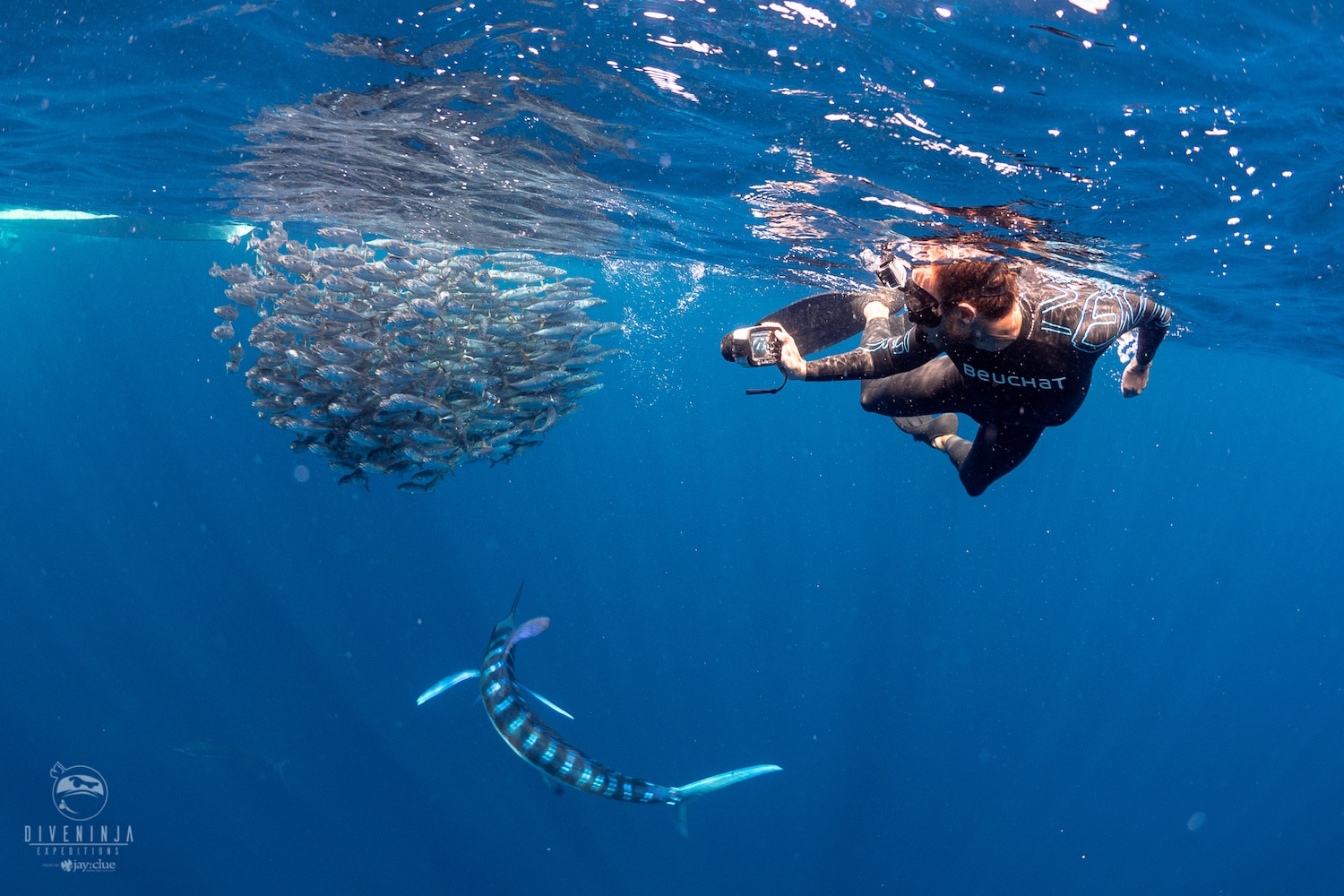
Slipping into the water gives you front row seats to one of the most action-packed experiences our oceans have to offer. Imagine over 40 Striped Marlin working together with packs of sea lions corralling their breakfast into a tight ball and pushing it up to the surface. Then one by one they rocket through the bait ball striking and spearing the fish with their sword-like bill.
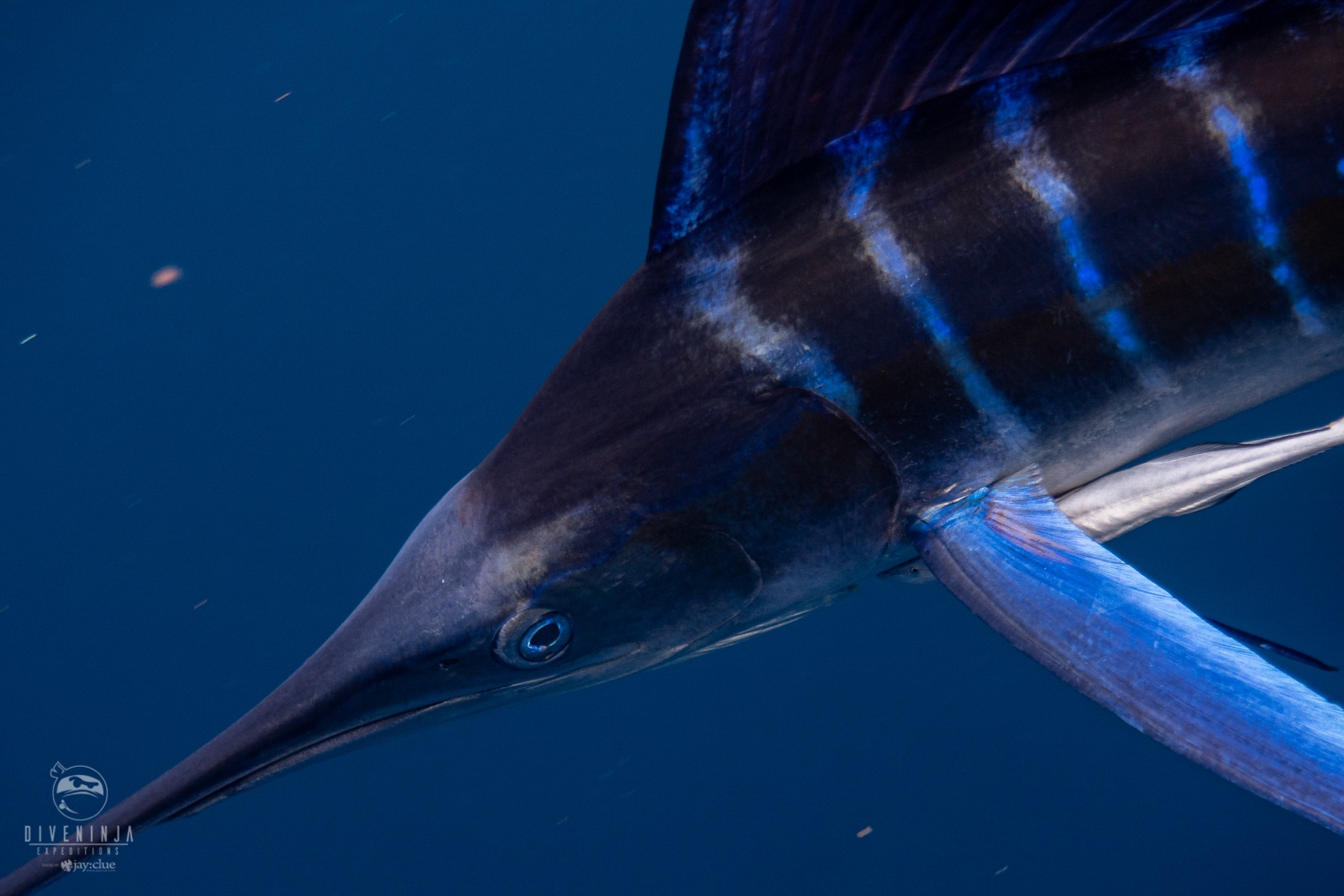
Without a moment to think they have already welcomed you into the hunt. It’s a heart pounding encounter, yet mesmerizingly beautiful. Thousands upon thousands of shimmering silver fish spiral into shapes reminiscent of liquid metal dancing on a gorgeous deep blue backdrop. All the while a barrage of sword wielding super-fish and the lions of the ocean ignite the waters around you.

Striped Marlin, Kajikia audax, are one of our ocean’s great creations. A super-fish engineered for extreme speed and vast open ocean migrations. They are one of the fastest animals in the ocean and capable of quickly reaching speeds of 80 kmh (50 mph). Striped marlin are a highly adapted apex predator. Their bodies have insets that allow their fins to lay completely flat when tucked in to help eliminate drag.
Marlin can even heat their eyes and brain to help them be able to manage such great speed and agility. Although not the largest species in the billfish family, they can grow nearly 4 meters (12 ft) long and weigh upwards of 190 kgs (450 lbs). Their long bill is covered in millions of rough denticles and is thought to decrease hydrodynamic drag as they slice through the water—in addition to being used for hunting and protection.
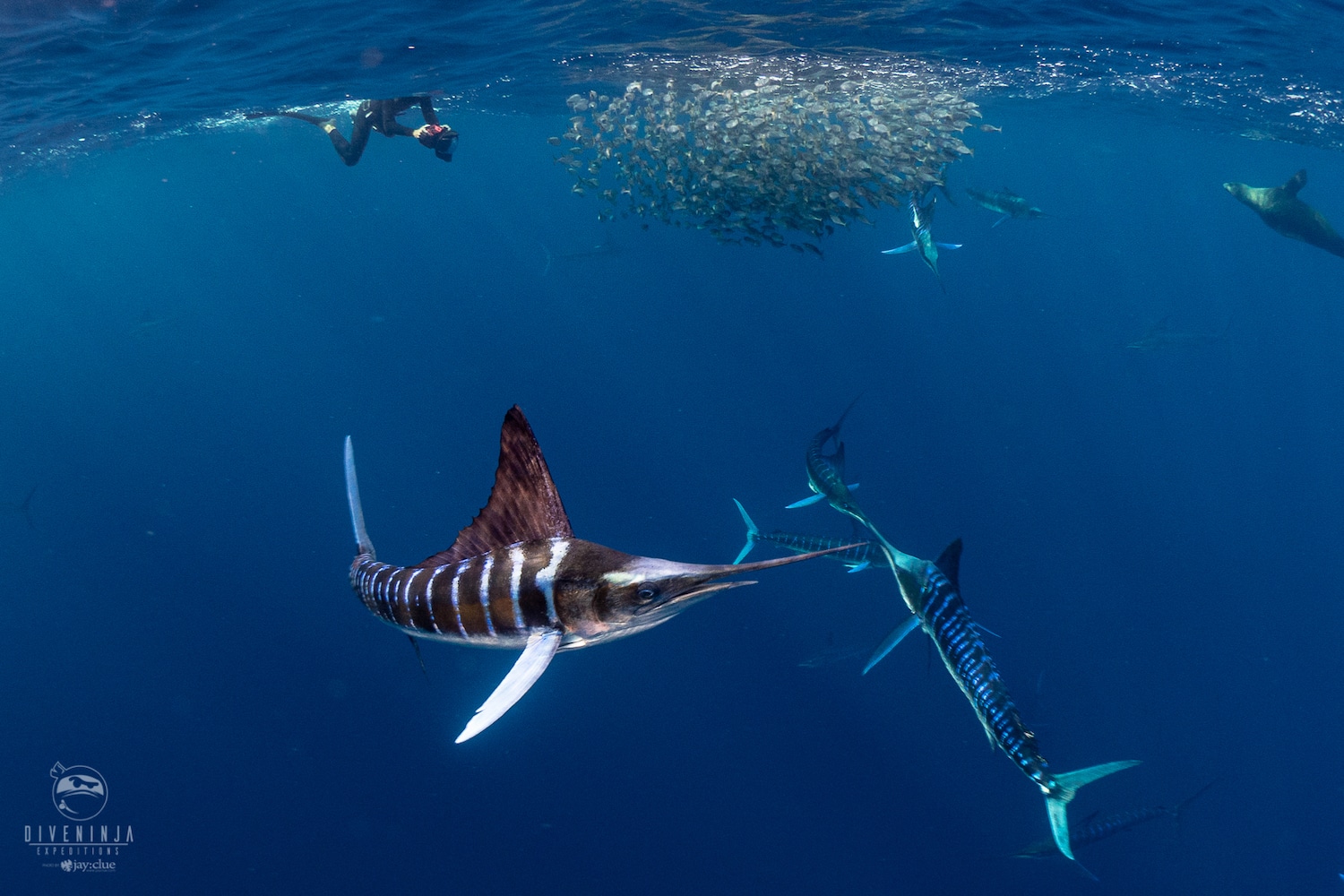
However, these beautiful creatures are listed as Near threatened on the IUCN Red List with their populations steadily decreasing. They are the prized subject of many sport fishermen and Los Cabos to the south is considered the sport fishing capital of the world. It hosts one of the largest sport fishing tournaments on earth as well as a big marina packed with sport fishing vessels running charters 365 days per year. It’s estimated that more than 12,000 striped marlin are fished each year just in the waters around Los Cabos.

Because of this Cabo San Lucas based Dive Ninja Expeditions has teamed up with Nakawe Project to integrate a new marlin research & conservation project into their annual marlin expeditions. The new project hopes to help better understand the population in Baja as well as look at the sustainability and impacts of fishing, while taking you to experience this awesome natural event firsthand.
How to Experience it
The season for these incredible striped marlin encounters takes place every autumn along the pacific coast of Baja California Sur, Mexico. The marlin normally begin to start arriving in late September and will stay through December. This means warmer, blue waters and good visibility. You’ll still want to pack a wetsuit, as this is the eastern Pacific, but a 5mm should be good for most. Your nearest major airport will be Los Cabos International, which offers direct flights from many US & Mexican cities.

Getting to the action though can be a bit of an undertaking, especially if you aren’t familiar with the area. There are a few locations where you can get in the water with the marlin, with the nearest one being a couple hours drive from Los Cabos. These are small fishing towns though, most without any proper tourism facilities. However, there are a couple operators that run multi-day trips out to experience the marlin and bait balls.
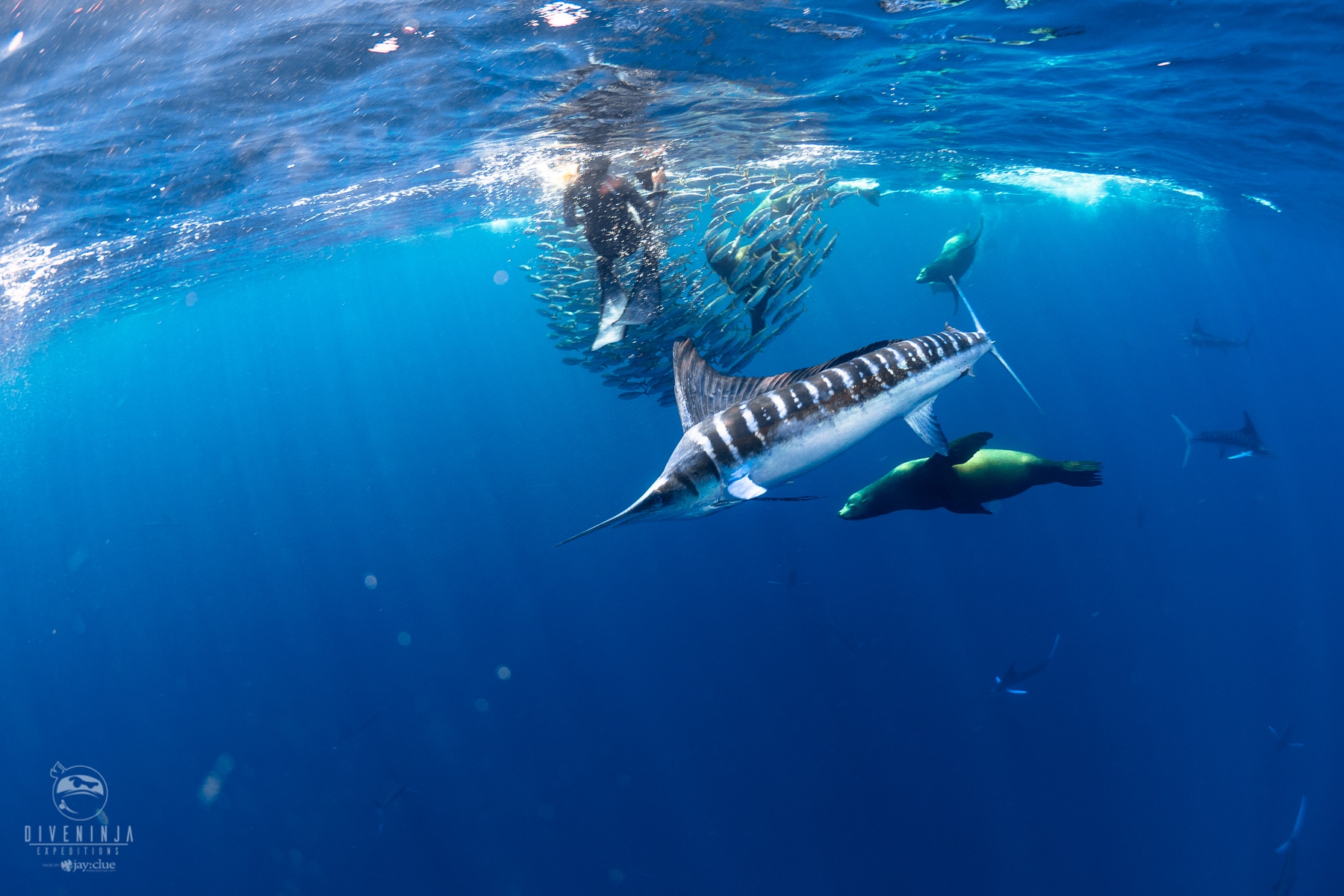
Dive Ninja Expeditions is one of the few operators that regularly run weekly trips each season. They have been actively working on projects in these areas for a few years that help support the local communities and further ongoing research and conservation efforts. They also work in these areas all year long on different specialized expeditions, so they know the local areas better than most. Whereas all of the other ops usually just pop in for a week or two each year.
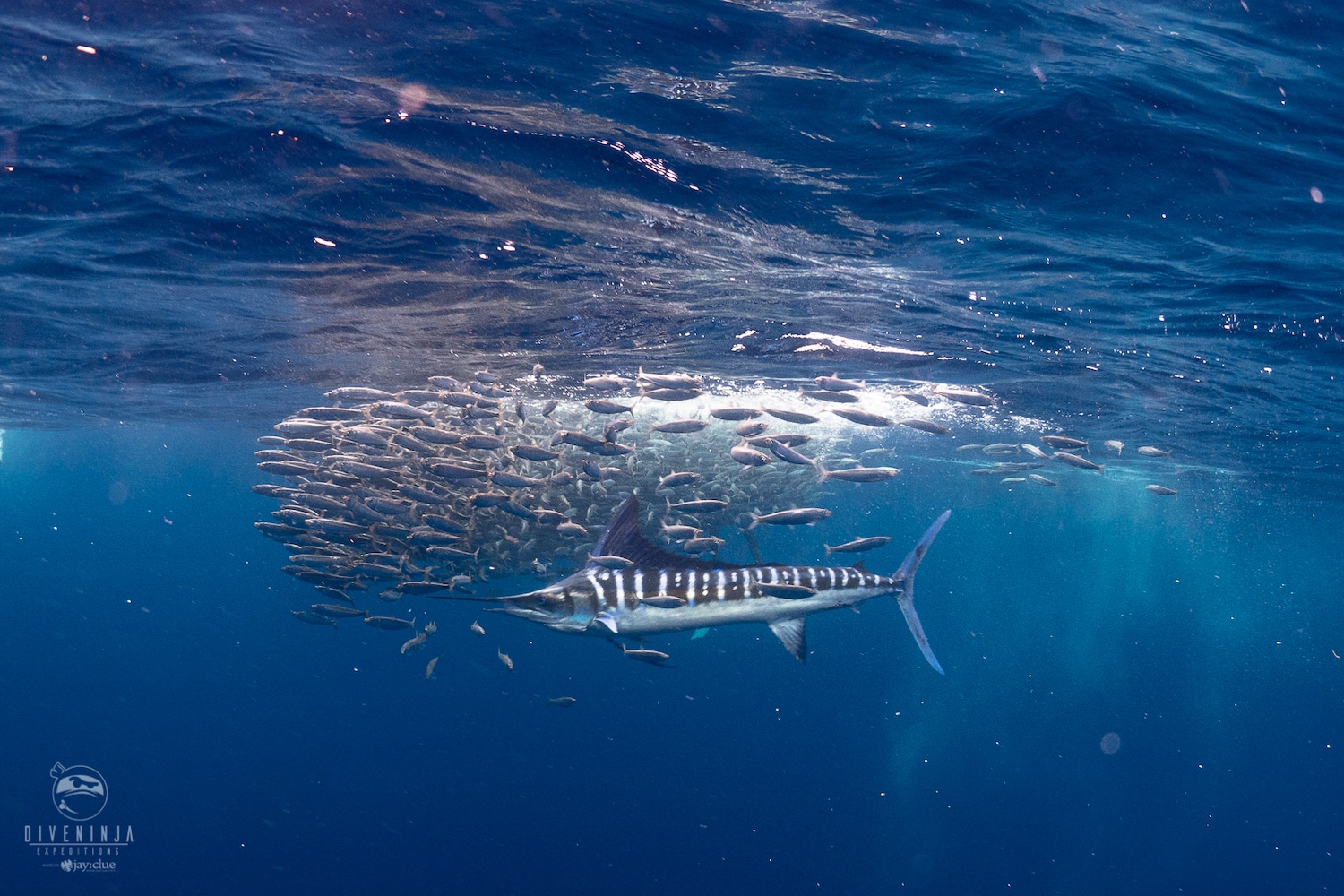
Due to the remoteness of these areas, and the speed at which the bait balls are moving, trips are usually more geared to freediving or snorkeling instead of scuba diving. But don’t sweat it because all the action takes place right at the surface. The marlin use the surface as a barrier to push the bait balls against, making them easier to hunt. So, enjoy not having to stress over airline baggage weight restrictions for this one!

Interested in exploring this adventure yourself? Visit the Dive Ninja Expeditions website. Their 2019 striped marlin season kicks off in the next few weeks and their 2020 Striped Marlin Expedition dates go on sale the beginning of October.
 For more from Jay Clue and Dive Ninja Expeditions, follow:
For more from Jay Clue and Dive Ninja Expeditions, follow:
Instagram: instagram.com/JayClue
Facebook: facebook.com/iamjayclue
Website: www.DiveNinjaExpeditions.com
Gear News
Introducing the TR-80, IR-50 and CS-30 Regulators from DYNAMICNORD

Whether you are a beginner or a professional diver – with the three new main regulators from DYNAMICNORD, everyone will find their favourite regulator. They all look super stylish.
Excellent performance with the TR-80
Quality and performance are the be-all and end-all for regulators. It is not for nothing that the TR stands for Tec Reg. The innovative design of the TR-80 guarantees absolute reliability – even in ice-cold waters.

Perfect breathing effort at 0.8 J/l / certified for diving in waters below 10 degrees / structural design made of solid brass for best cold protection / membrane-compensated design with dry seal of the first stage / reduced exhalation effort thanks to optimized exhalation membrane and bubble deflector / adjustable Venturi (dive/predive) and adjustment knob for individual inhalation comfort / innovative design of the front cover prevents free-flow in strong currents or when diving with scooters / design made of sandblasted brass, matt chrome finish / 2 HP and 4 LP outlets / mouthpiece made of high-quality, anti-allergic silicone for maximum comfort.


Amazing underwater adventures with the IR-50
The IR-50 is the top regulator for advanced and experienced divers. Natural breathing is the essence of this regulator.

Ideal breathing effort at 0.8 J/l /certified for diving in waters below 10 degrees / compensated membrane / adjustable venturi (dive/predive) and adjustment knob for individual inhalation comfort/ outlet valve and deflector for minimum exhalation effort and reduction of bubbles on the face / design made of sandblasted brass, matt chrome finish / 2 HP and 4 NP outlets / mouthpiece made of high-quality, anti-allergic silicone for maximum comfort.


The Workhorse – our CS-30
For diving centres and diving beginners – the workhorse stands for strong construction, reliability and robustness. Perfect for your training.

Optimal breathing effort at 0.8 J/l /recommended for diving in waters above 10 degrees / non-compensated piston / adjustable venturi (dive/predive) / outlet valve and deflector for minimum exhalation effort and reduction of bubbles on the face / design made of sandblasted brass, matt chrome finish / 1 HP and 3 NP outlets / mouthpiece made of high-quality, anti-allergic silicone for maximum comfort.


Octopus OP-30
The OP-30 is the ideal addition to all DYNAMICNORD regulators. It is identical in construction to the CS-30.

The TR-80, IR-50, CS-30 (DIN & INT) regulators and the Octopus OP-30 are available from DYNAMICNORD dealers and in the online store.
DYNAMICNORD – Your Outdoor Companion.
Marine Life & Conservation
Paul Watson Released as Denmark Blocks Japan’s Extradition Bid

Renowned anti-whaling activist Paul Watson has been released from custody in Greenland after spending five months in detention. Denmark’s Justice Ministry rejected Japan’s request for his extradition, citing insufficient guarantees that his time already served in custody would be credited against any potential sentence.
The 74-year-old Canadian-American was arrested on July 21 in Nuuk, Greenland’s capital, when his ship docked to refuel. His arrest was based on a 2012 Japanese warrant related to a 2010 encounter in Antarctic waters. Japan alleged Watson obstructed operations and caused damage to a whaling research ship during efforts to disrupt illegal whaling. Watson has consistently denied these claims, maintaining his commitment to marine conservation.
Denmark, which oversees extradition matters for Greenland, concluded that while the legal conditions for extradition were met, the lack of assurances from Japan regarding time-served credit made extradition untenable.
In a video shared by his foundation, Watson expressed gratitude and relief, saying, “After five months, it’s good to be out… and good to know they’re not sending me to Japan.” He added that the most difficult part of his time in custody was being separated from his two young sons.
Watson is a pioneering figure in marine conservation, known for founding the Captain Paul Watson Foundation in 2022 after decades of activism with the Sea Shepherd Conservation Society. His bold efforts to defend marine life have earned him widespread support, including from celebrities and conservationists. His work has also been featured in the acclaimed reality TV series Whale Wars.
Watson’s lawyer, Jonas Christoffersen, praised the decision, stating, “We are happy and relieved that Paul Watson is now free.” He added that Watson is eager to reunite with his family and continue his vital work.
The arrest occurred while Watson’s vessel, the M/Y John Paul DeJoria, was en route to the North Pacific with a team of 26 volunteers to intercept a Japanese whaling ship. His foundation described the arrest as politically motivated and emphasized that Watson’s actions were focused on ending illegal whaling practices.
Japan resumed commercial whaling in 2019 after leaving the International Whaling Commission, asserting that whale meat is a cultural tradition. Conservationists, however, continue to challenge these practices, highlighting their impact on marine ecosystems.
Despite the challenges, Watson remains steadfast in his mission to protect marine life and bring attention to whaling practices. His dedication to ocean conservation has made him a globally respected advocate for the environment.
-

 News2 months ago
News2 months agoIconic SS United States to become the World’s Largest Artificial Reef
-

 News3 months ago
News3 months agoBook Review – 52 Assignments: Underwater Photography
-

 Gear News3 months ago
Gear News3 months agoDYNAMICNORD – New German diving brand enters the British market
-

 News3 months ago
News3 months agoExploring Cenote El Pit: A Diver’s Dream
-

 Gear News3 months ago
Gear News3 months agoTry BARE drysuits (and maybe even win one!) this Friday with Sea & Sea at North West Dive Fest
-

 Marine Life & Conservation3 months ago
Marine Life & Conservation3 months agoBook Review: Coral Triangle Cameos
-

 Blogs2 months ago
Blogs2 months agoDive the Egyptian Red Sea this Autumn with Regaldive
-

 News3 months ago
News3 months ago2024 Ocean Art Underwater Photo Competition Announced















